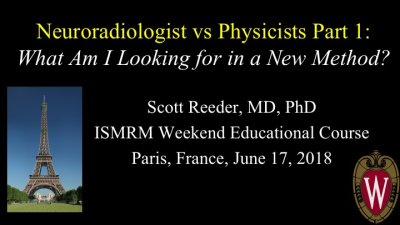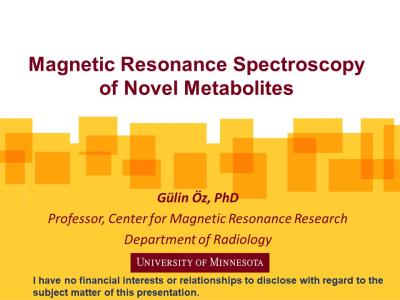|
Weekend Educational Course
Lost in Translation: Neuroradiologists vs Physicists |
|
Lost in Translation: Neuroradiologists vs Physicists: Part 1
Weekend Course
ORGANIZERS: Christopher Hess, Alex MacKay
Sunday, 17 June 2018
| S03 |
08:00 - 09:50 |
Moderators: Christopher Hess, Alex MacKay |
Skill Level: Basic
Session Number: WE-19A
Overview
This translational session is intended to facilitate discussion between neuroradiologists and MRI physicists working in neurological applications.
Two competing questions will be posed: a) Why don't you use my
techniques? and b) Why don't you design techniques that are useful?
Target Audience
Trainees, scientists, physicists, engineers, radiologists wishing to understand clinical perspectives and new MR techniques.
Educational Objectives
As a result of attending this course, participants should be able to:
-Recognize open clinical questions not currently answered using available MR techniques;
-Summarize the strengths, limitations and potential clinical applications of new MR methods; and
-Facilitate discussion among radiologists, MR physicists and engineers.
08:00
|
 |
 What Am I Looking for in a New Technique? What Am I Looking for in a New Technique?
Scott Reeder
Acceptance of a new technique generally requires that the acquisition have one or more of the following qualities: faster, more robust/reliable, improved image quality, or offers new information not previously available by other acquisition techniques. Evaluation of new imaging techniques should focus on the specific anatomy of interest or on a specific clinical question, not the overall appearance of an image. Ultimately, determination of clinical impact requires evaluation of diagnostic accuracy, clinical effectiveness and the impact on clinical decision-making. Effective development and translation of new imaging techniques into clinical care requires partnership with clinical imaging experts.
|
08:20
|
|
 Brain Perspective Brain Perspective
Ari Blitz
|
08:40
|
|
Spine Perspective
Did Not Present
Majda Thurnher
|
09:00
|
|
 Head & Neck Perspective Head & Neck Perspective
Christine Glastonbury
While spatial and contrast resolution has greatly advanced in HN MR imaging and extraordinary detail can be seen with cranial nerve and inner ear imaging, our greatest problem in HN imaging remains the routine neck scan. Obtaining at least two-plane imaging of the neck with T1, T2 FS and T1 post contrast FS sequences is necessary. Diffusion weighted imaging has become an essential component of neck and skull base imaging and should also be included in a HN protocol. Trying to achieve at least 6 sequences in a reasonable time frame is problematic for HN MR imaging, and trying to achieve it with patients who have difficulty with secretion management after chemoradiation is even more complex.
|
09:20
|
|
 What Do I Need to Know to Design a New Technique? What Do I Need to Know to Design a New Technique?
Jeffrey Duerk
|
09:40
|
|
Break & Meet the Teachers |
|
| |
|
Lost in Translation: Neuroradiologists vs Physicists: Part 2
Weekend Course
ORGANIZERS: Christopher Hess, Alex MacKay
Sunday, 17 June 2018
| S03 |
10:10 - 12:00 |
Moderators: Christopher Hess, Alex MacKay |
Skill Level: Basic
Session Number: WE-19B
Overview
This translational session is intended to facilitate discussion between neuroradiologists and MRI physicists working in neurological applications. Two competing questions will be posed: a) Why don't you use my techniques? and b) Why don't you design techniques that are useful?
Target Audience
Trainees, scientists, physicists, engineers, radiologists wishing to understand clinical perspectives and new MR techniques.
Educational Objectives
As a result of attending this course, participants should be able to:
-Recognize open clinical questions not currently answered using available MR techniques;
-Summarize the strengths, limitations, and potential clinical applications of new MR methods; and
-Facilitate discussion among radiologists, MR physicists, and engineers.
10:10
|
|
 Fast Imaging - Parallel Imaging, Compressed Sensing & Beyond Fast Imaging - Parallel Imaging, Compressed Sensing & Beyond
John Pauly
Throughout the history of MRI a long sequences of techniques have been developed to make images with less data. When MRI first emerged as a clinical imaging modality, images were acquired by fully sampling a rectangular region in spatial-frequency, or k-space. Faster acquisitions have been based on the structure of the data, knowledge of the receive array sensitivity, models of the statistics of the image, and, more recently, models of the images themselves. The common thread is using other knowledge we have about the MRI system and subject to provide additional prior information to reduce the amount of data we need to collect. This talk will highlight this sequence of methods, and look at the potential and challenges they present for clinical application.
|
10:32
|
|
 Modern Functional & Diffusion Imaging Modern Functional & Diffusion Imaging
Mara Cercignani
Diffusion and functional MRI are among the most popular MRI techniques used in neuroscience research. Although basic versions of these techniques have found their way to the clinic relatively soon after their introduction, almost none of the technological advances introduced in the past 20 years have been adopted outside the research setting. This lecture will review some of the latest flavours of diffusion and functional MRI and their potential clinical applications
|
10:54
|
|
 Fingerprinting & Synthetic MRI Fingerprinting & Synthetic MRI
Nicole Seiberlich
|
11:16
|
 |
 MRS of Novel Metabolites MRS of Novel Metabolites
Gulin Oz
This talk will start with an overview of neurochemicals (beyond NAA, Cr, Cho) measurable by MRS and the cellular/biochemical processes that they reflect, present examples of their utility in addressing novel biological questions, then follow with data quality requirements to be able to reliably quantify these neurochemical profiles and finish with a summary of recent efforts to simplify and automate acquisition of high quality MRS data at 3T and make advanced MRS acquisitions MR technologist friendly.
|
11:38
|
|
Panel Discussion |
12:00
|
|
Adjournment & Meet the Teachers |
|
| Back |
| The International Society for Magnetic Resonance in Medicine is accredited by the Accreditation Council for Continuing Medical Education to provide continuing medical education for physicians. |



